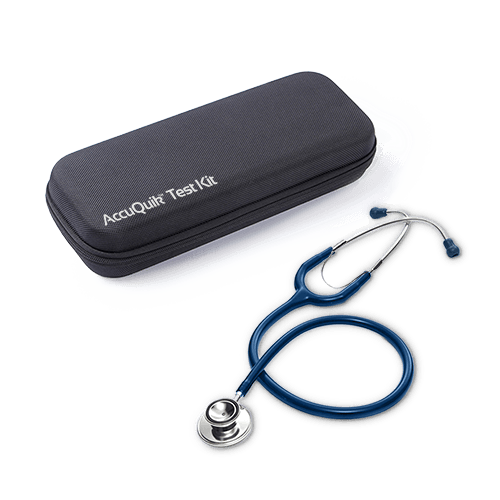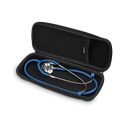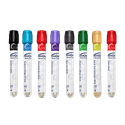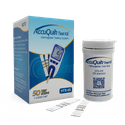Stethoscope
Type
Material
Color
Packaging
What is a Stethoscope?
A Stethoscope is a medical diagnostic tool used to listen to various sounds produced by the body. It is commonly used by healthcare professionals for auscultation. The stethoscope consists of a flexible tube that is attached to two earpieces and a chest piece, which usually contains a diaphragm and a bell.
Stethoscopes are available as single-head or double-head and made from PVC and one of the following metal options: zinc alloy, aluminum alloy, or titanium. Stethoscopes are available in a wide range of colors, including black, blue, green, red, and yellow, which allows for convenient identification and personalization.
AdvaCare Pharma manufactures Stethoscopes in ISO and CE-certified facilities located in India, China, and the USA. Every production factory undergoes routine inspections to ensure strict compliance with healthcare standards and the highest levels of quality and safety.
Product Specifications
Type
Single-Head stethoscope features a tunable diaphragm used for the auscultation procedure. The tunable diaphragm technology enables accurate detection of both low and high-pitched body sounds, providing healthcare professionals with enhanced diagnostic capabilities.
The single-head stethoscope is a high-quality medical device designed for precise and efficient auscultation procedures. The acoustic tubing efficiently transmits sound from the chest piece to the earpieces, allowing for clear and detailed sound perception.
Double-Head stethoscope is equipped with a regular diaphragm on one side and a bell (or pediatric diaphragm) on the other side. The regular diaphragm is designed for listening to high-frequency sounds such as heart and lung sounds, while the bell or pediatric diaphragm is suitable for low-frequency sounds like murmurs or fetal heart sounds.
Why are we a top Stethoscope manufacturer?
AdvaCare Pharma is a reputable and leading manufacturer of stethoscopes. Our company offers an extensive range of over 4,000 globally recognized pharmaceuticals, medical devices, supplements, and veterinary products. To ensure the quality of the Accuquick diagnostic detection devices, we adhere to stringent CE and ISO regulations at our production facilities.
AdvaCare Pharma's approach to supply chain management is systematic and data-driven. This helps optimize our resources, which delivers greater value to our clients and end-users. Our well-established worldwide partners include hospitals, pharmacies, distributors, NGOs, and government institutions.
Uses
What is a Stethoscope used for?
A Stethoscope is a medical diagnostic tool, needed for auscultating and interpreting various sounds produced by the body. Healthcare professionals rely on stethoscopes during physical examinations to assess the cardiovascular, respiratory, and gastrointestinal systems.
Listening to heartbeats, lung sounds, and bowel sounds, among others, clinicians can then detect abnormalities, monitor conditions, and make informed diagnostic decisions. For example, the distinctive sounds of heart murmurs or crackles in the lungs can indicate underlying cardiac or pulmonary issues, respectively.
Stethoscopes are used across many medical specialties, from general practice to cardiology, pediatrics, and emergency medicine, leading to accurate assessments and timely interventions. With their versatility and reliability, stethoscopes have their part in patient care and contribute to the diagnostic process.
How is a Stethoscope used?
Using a Stethoscope involves a systematic approach to place the chest piece appropriately on the patient's body over the area of interest, such as the chest, back, or abdomen. The healthcare professional then listens attentively through the stethoscope tubing, focusing on the specific sounds relevant to the examination.
For cardiac auscultation, the chest piece is positioned over different areas of the chest to listen to heart sounds, including the four classic valve areas. Similarly, lung sounds are evaluated by placing the chest piece over different lung fields, assessing for normal vesicular breath sounds or abnormal findings like crackles or wheezes. Abdominal auscultation involves listening for bowel sounds and bruits over various abdominal quadrants.
Throughout the examination, clinicians use their expertise to interpret the sounds heard and correlate them with clinical findings to make accurate diagnoses and treatment decisions. The use of a stethoscope requires both skill and experience, as healthcare professionals must be proficient in recognizing subtle variations in sound quality and intensity, which can provide valuable diagnostic insights.
Are there any specific storage requirements for Stethoscopes?
To maintain the integrity and functionality of Stethoscopes, it is advisable to store them in a dedicated case or pouch specifically designed for stethoscope storage. Proper storage helps protect the delicate components of the stethoscope, such as the chest piece, tubing, and earpieces, from damage, dust, and environmental contaminants.
Storing the stethoscope in a clean and dry environment also reduces the risk of microbial contamination. Storing the stethoscope in its designated case or pouch prevents entanglement with other objects and minimizes the risk of accidental damage during transportation or storage.
Through following these storage recommendations, healthcare professionals can guarantee that their stethoscopes remain in perfect condition for reliable auscultation during patient examinations. Proper maintenance and care of the stethoscope, including regular cleaning and inspection of components, further contribute to its longevity and performance.
How does a Stethoscope work in a medical environment?
In a medical environment, a Stethoscope is a foundational tool for healthcare professionals across various specialties, including physicians, nurses, and paramedics. The functionality of a stethoscope lies in its ability to amplify and transmit internal body sounds to the examiner's ears, enabling the detection and interpretation of physiological sounds indicative of organ function or dysfunction.
During patient examinations, healthcare providers use stethoscopes to auscultate a wide range of sounds, such as heart murmurs, lung sounds, and bowel sounds, which are all-important for diagnosing and monitoring medical conditions. For example, cardiologists rely on stethoscopes to detect abnormal heart sounds, assess heart rate and rhythm, and diagnose cardiac abnormalities like valvular disorders or arrhythmias.
Similarly, pulmonologists utilize stethoscopes to evaluate lung sounds and diagnose respiratory conditions such as pneumonia, asthma, or chronic obstructive pulmonary disease (COPD). In emergency medicine settings, stethoscopes assist in rapid assessments of critically ill patients, helping healthcare workers identify life-threatening conditions such as pneumothorax or cardiac tamponade.
The use of stethoscopes in medical environments increases diagnostic accuracy, encourages prompt interventions, and leads to better patient outcomes.
What are the advantages of using a Stethoscope in medical examinations?
The use of a Stethoscope offers several advantages in medical examinations. Stethoscopes supply non-invasive and real-time assessment of internal body sounds, allowing clinicians to gather valuable diagnostic information without the need for invasive procedures or imaging tests. This enables rapid bedside assessments, particularly in emergency situations where timely interventions are of the essence.
Stethoscopes present versatility in auscultation, as they can be used to evaluate multiple organ systems, including the cardiovascular, respiratory, and gastrointestinal systems. With their ability to detect subtle changes in sound quality and intensity, stethoscopes aid in the early detection of abnormalities and the monitoring of disease progression.
Stethoscopes permit direct interaction between practitioners and patients during physical examinations, fostering trust, communication, and patient engagement in their healthcare journey.
These devices are portable, lightweight, and easy to use, making them suitable for use in various clinical settings, including hospitals, clinics, and ambulatory care settings.
They are inexpensive diagnostic tools that afford reliable performance and durability, providing long-term value to healthcare personnel and institutions. The advantages of using stethoscopes in medical examinations include their accessibility, versatility, reliability, and patient-centered approach to diagnosis and care.
What are the main considerations for selecting a Stethoscope for medical use?
Selecting the right Stethoscope for medical use involves careful consideration of several factors to ascertain peak performance, reliability, and suitability for the intended clinical application:
- Healthcare professionals must choose between single-head and double-head stethoscopes based on their specific auscultation needs and preferences. Single-head stethoscopes feature a tunable diaphragm for listening to both low and high-frequency sounds, making them suitable for general auscultation purposes. On the other hand, double-head stethoscopes bring the convenience of having both a regular diaphragm and a bell, yielding versatility for a broader range of auscultation needs.
- Physicians should consider the material construction of the stethoscope, including options such as zinc alloy, aluminum alloy, or titanium, to confirm durability, acoustic performance, and comfort during prolonged use.
- The choice of tubing material, such as PVC or latex-free materials, can impact sound transmission and maintenance requirements. Clinicians should select a stethoscope with appropriate chest piece size and design to accommodate different patient populations, including adults, children, and infants.
- Considerations such as chest piece diameter and bell size should be tailored to the clinician's scope of practice and patient demographics.
- Clinicians may opt for stethoscopes with additional features such as ambient noise reduction, adjustable earpieces, or customizable tubing colors for personalization and ease of identification.
FAQs
How does a Stethoscope work?
It works by transmitting sound waves from the chest piece, through the tubing of the stethoscope and to reach the earpieces.
Should a single-head stethoscope or a double-head stethoscope be used?
The choice between the two styles of stethoscopes is dependent on the needs and preferences of the healthcare professional. A single-head stethoscope has a tunable diaphragm, allowing an easier switch between low and high frequencies. It is suitable for general auscultation purposes. The double-head stethoscope offers the convenience of having both a regular diaphragm and a bell, which is more versatile for a broader range of auscultation needs.
Are there specific cleaning and maintenance instructions for a Stethoscope?
The proper cleaning and maintenance are essential for the longevity and hygiene of a stethoscope. Before and after each use, it is advised to wipe the chest piece, tubing, and earpieces with an alcohol-based disinfectant. It is best to avoid putting the stethoscope into liquid. This can damage the internal components. The tubing should be regularly inspected for any signs of wear.
References
Proper Use of the Stethoscope: Three Heads and One Tale
This study delves into the creation of the stethoscope in 1816 by René Laennec, highlighting its significance in amplifying sound frequencies and intensities to enhance diagnosis. It also discusses the challenges doctors faced in using the stethoscope effectively due to various factors like sound distance and chest shape. The study emphasizes the importance of mastering the proper use of the stethoscope to improve examination findings and reduce reliance on additional technologies like echocardiography.
In Defense of the Stethoscope
Despite debates on its reliability, this article defends the stethoscope as a valuable diagnostic tool in clinical medicine. It presents evidence supporting the use of stethoscopes, emphasizing their importance in providing crucial diagnostic information, especially through auscultation with an acoustic stethoscope.
You might be interested in...
Why AdvaCare Pharma?
As an industry leader, we are aware of our responsibility to provide affordable and sustainable solutions to improve healthcare worldwide.











